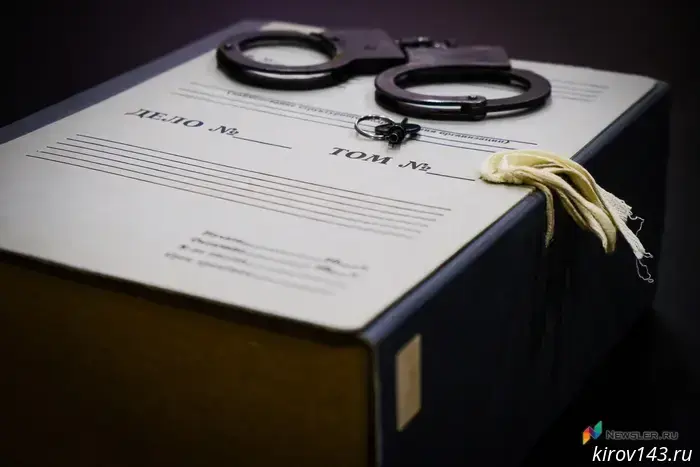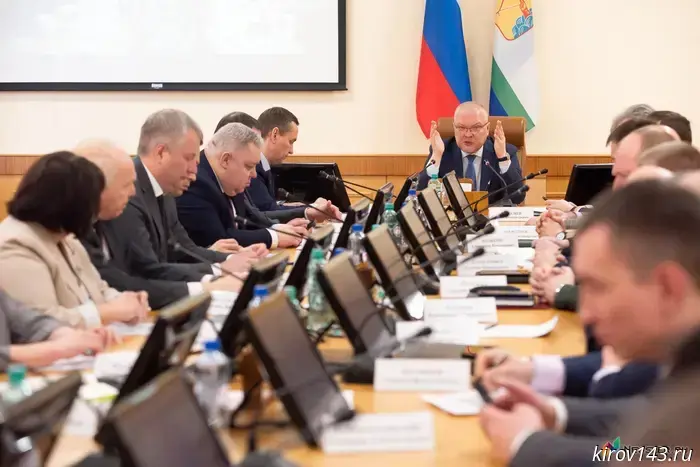
В Кировской области в результате погодных условий возможны повреждения 20 мостов.
Согласно заявлению представителя регионального управления МЧС, в Кировской области ожидаются сезонные риски по 20 плавным, понтонным и деревянным мостам. Поскольку реки начинают покрываться льдом, возникла угроза повреждения и разрушения мостов. Докладчик предложил поручить муниципалитетам совместно с обслуживающими организациями либо укрепить мосты, либо разобрать их, а также обратить внимание на вопросы жизнедеятельности населения. В правительстве пообещали заняться этой проблемой.


Другие Новости Кирова (НЗК)
![Lauren Chan is a Who What Wear editor in residence, model, former award-winning fashion editor, and founder of Henning, a luxury plus-size clothing brand. While preparing for my wedding, one of my initial steps was to open Instagram and search for “lesbian wedding.” Instead of finding an abundance of content, I encountered a blank page stating: “No results found for ‘lesbian wedding.’” I assumed there was a minor glitch with the app, so to check, I searched for “wedding” and—voila!—a wide array of content appeared. This experience symbolized how I would navigate the wedding industry as a queer bride.
As I continued planning, I was constantly reminded that the wedding industry isn’t designed for LGBTQ+ individuals. I felt a sense of exclusion—whether from the dominant beauty standards reflected in magazines and advertisements or the absence of cards and cakes that said “Mrs. & Mrs.” Getting ready for the big day was no different: bridal fashion brands often do not cater to a queer perspective. Though it may seem trivial, it is crucial to highlight this disparity, especially in a culture where the Supreme Court is contemplating the possibility of overturning marriage equality in Obergefell v. Hodges (the significant 2015 case that legalized same-sex marriage), and more importantly, to celebrate how queer individuals move forward, discover joy, and provide representation within our community.
That’s why I chose to speak with other brides who, despite their struggles in finding wedding attire at traditional bridal shops, found alternative ways to dress: author Tembe Denton-Hurst, model Kelly Hess (Mittendorf), and creator Becca Calegari. So where did they shop? And what insights did they gain? Here’s what I learned.
Tembe Denton-Hurst Followed Ellie Misner on Instagram
“It just looked ugly,” said Denton-Hurst regarding the bridal market during her dress shopping. She elaborated, “Bridal was… princess.” When I inquired about her shopping journey, she quickly replied, “I didn’t shop.” Denton-Hurst recognized there was no chance she could purchase something off the rack that she liked in a size 18. (Bridal size exclusivity deserves its own discussion.) She observed her peers leaning towards the styles of Vivienne Westwood and Danielle Frankel, but none resonated with her own style. "We have our own aesthetic codes," she remarked. "I had a very Black wedding and very lesbian wedding. Visual representation was important."
Initially, Denton-Hurst discussed a custom gown vision with Wiederhoeft, but when that plan fell through, she felt uncertain. "Then I stumbled upon Paloma Elsesser’s Instagram, where she wore a corset by Ellie Misner, who creates 'couture for all bodies,'" she shared. A quick DM later, and the rest is history.
The final designs by Misner consisted of two ivory looks: one a two-piece minidress and corset with an off-the-shoulder layer, and the other a classic basque-waist gown featuring hip pads. The padding (my favorite element!) was inspired by the female gaze and Denton-Hurst’s wife, Connay Bratton. “I’m not afraid of mass,” she said. "There’s often a tendency for people to try to be as small as possible on their wedding days. But [Connay] has made me embrace my body; I never felt the need to hide any part of myself."
"I like an androgynous aesthetic," Calegari stated. "It’s obviously challenging for masculine-leaning women to find that in a conventional bridal store. But just because you don’t fit the 'bride' mold doesn’t mean you are any less significant. You can still embody that without the heels, veil, or dress." Calegari, who typically wears tailored pieces from brands like Ralph Lauren and Cinq à Sept, collaborated with designer James Ford. Despite Ford’s appearance on the Netflix series Next in Fashion, Calegari discovered him within her queer community in Los Angeles. "Through a friend of a friend," she shared. "We connected and hit it off."
Hit it off is an understatement based on Calegari’s description of their process: "He came over to our home to draw inspiration from our surroundings and get to know [my wife and I] in our own space. He brought books and swatches and was able to see what excited me." Together, they designed a fitted straight-leg, peak-lapel, double-breasted suit featuring tonal brocade. Underneath, Calegari wore a silky matching button-up. Every detail was intentional, including the word "gentlewoman" embroidered on the inner pocket of the suit. Interestingly, the look was a classic bridal white.
“We both wanted to wear white,” emphasized her wife](https://kirov143.ru/thumbs/kirov143.ru-700/e9/1b/Feeding-Children-switched-to-fattening-up-the-governor.webp) Lauren Chan is a Who What Wear editor in residence, model, former award-winning fashion editor, and founder of Henning, a luxury plus-size clothing brand. While preparing for my wedding, one of my initial steps was to open Instagram and search for “lesbian wedding.” Instead of finding an abundance of content, I encountered a blank page stating: “No results found for ‘lesbian wedding.’” I assumed there was a minor glitch with the app, so to check, I searched for “wedding” and—voila!—a wide array of content appeared. This experience symbolized how I would navigate the wedding industry as a queer bride.
As I continued planning, I was constantly reminded that the wedding industry isn’t designed for LGBTQ+ individuals. I felt a sense of exclusion—whether from the dominant beauty standards reflected in magazines and advertisements or the absence of cards and cakes that said “Mrs. & Mrs.” Getting ready for the big day was no different: bridal fashion brands often do not cater to a queer perspective. Though it may seem trivial, it is crucial to highlight this disparity, especially in a culture where the Supreme Court is contemplating the possibility of overturning marriage equality in Obergefell v. Hodges (the significant 2015 case that legalized same-sex marriage), and more importantly, to celebrate how queer individuals move forward, discover joy, and provide representation within our community.
That’s why I chose to speak with other brides who, despite their struggles in finding wedding attire at traditional bridal shops, found alternative ways to dress: author Tembe Denton-Hurst, model Kelly Hess (Mittendorf), and creator Becca Calegari. So where did they shop? And what insights did they gain? Here’s what I learned.
Tembe Denton-Hurst Followed Ellie Misner on Instagram
“It just looked ugly,” said Denton-Hurst regarding the bridal market during her dress shopping. She elaborated, “Bridal was… princess.” When I inquired about her shopping journey, she quickly replied, “I didn’t shop.” Denton-Hurst recognized there was no chance she could purchase something off the rack that she liked in a size 18. (Bridal size exclusivity deserves its own discussion.) She observed her peers leaning towards the styles of Vivienne Westwood and Danielle Frankel, but none resonated with her own style. "We have our own aesthetic codes," she remarked. "I had a very Black wedding and very lesbian wedding. Visual representation was important."
Initially, Denton-Hurst discussed a custom gown vision with Wiederhoeft, but when that plan fell through, she felt uncertain. "Then I stumbled upon Paloma Elsesser’s Instagram, where she wore a corset by Ellie Misner, who creates 'couture for all bodies,'" she shared. A quick DM later, and the rest is history.
The final designs by Misner consisted of two ivory looks: one a two-piece minidress and corset with an off-the-shoulder layer, and the other a classic basque-waist gown featuring hip pads. The padding (my favorite element!) was inspired by the female gaze and Denton-Hurst’s wife, Connay Bratton. “I’m not afraid of mass,” she said. "There’s often a tendency for people to try to be as small as possible on their wedding days. But [Connay] has made me embrace my body; I never felt the need to hide any part of myself."
"I like an androgynous aesthetic," Calegari stated. "It’s obviously challenging for masculine-leaning women to find that in a conventional bridal store. But just because you don’t fit the 'bride' mold doesn’t mean you are any less significant. You can still embody that without the heels, veil, or dress." Calegari, who typically wears tailored pieces from brands like Ralph Lauren and Cinq à Sept, collaborated with designer James Ford. Despite Ford’s appearance on the Netflix series Next in Fashion, Calegari discovered him within her queer community in Los Angeles. "Through a friend of a friend," she shared. "We connected and hit it off."
Hit it off is an understatement based on Calegari’s description of their process: "He came over to our home to draw inspiration from our surroundings and get to know [my wife and I] in our own space. He brought books and swatches and was able to see what excited me." Together, they designed a fitted straight-leg, peak-lapel, double-breasted suit featuring tonal brocade. Underneath, Calegari wore a silky matching button-up. Every detail was intentional, including the word "gentlewoman" embroidered on the inner pocket of the suit. Interestingly, the look was a classic bridal white.
“We both wanted to wear white,” emphasized her wife
Бывший директор муниципального «Комбината продовольствия и социального питания» Денис Ситников, совершив впечатляющий карьерный скачок, с 29 октября занимает должность директора областного «Комбината питания».
Lauren Chan is a Who What Wear editor in residence, model, former award-winning fashion editor, and founder of Henning, a luxury plus-size clothing brand. While preparing for my wedding, one of my initial steps was to open Instagram and search for “lesbian wedding.” Instead of finding an abundance of content, I encountered a blank page stating: “No results found for ‘lesbian wedding.’” I assumed there was a minor glitch with the app, so to check, I searched for “wedding” and—voila!—a wide array of content appeared. This experience symbolized how I would navigate the wedding industry as a queer bride.
As I continued planning, I was constantly reminded that the wedding industry isn’t designed for LGBTQ+ individuals. I felt a sense of exclusion—whether from the dominant beauty standards reflected in magazines and advertisements or the absence of cards and cakes that said “Mrs. & Mrs.” Getting ready for the big day was no different: bridal fashion brands often do not cater to a queer perspective. Though it may seem trivial, it is crucial to highlight this disparity, especially in a culture where the Supreme Court is contemplating the possibility of overturning marriage equality in Obergefell v. Hodges (the significant 2015 case that legalized same-sex marriage), and more importantly, to celebrate how queer individuals move forward, discover joy, and provide representation within our community.
That’s why I chose to speak with other brides who, despite their struggles in finding wedding attire at traditional bridal shops, found alternative ways to dress: author Tembe Denton-Hurst, model Kelly Hess (Mittendorf), and creator Becca Calegari. So where did they shop? And what insights did they gain? Here’s what I learned.
Tembe Denton-Hurst Followed Ellie Misner on Instagram
“It just looked ugly,” said Denton-Hurst regarding the bridal market during her dress shopping. She elaborated, “Bridal was… princess.” When I inquired about her shopping journey, she quickly replied, “I didn’t shop.” Denton-Hurst recognized there was no chance she could purchase something off the rack that she liked in a size 18. (Bridal size exclusivity deserves its own discussion.) She observed her peers leaning towards the styles of Vivienne Westwood and Danielle Frankel, but none resonated with her own style. "We have our own aesthetic codes," she remarked. "I had a very Black wedding and very lesbian wedding. Visual representation was important."
Initially, Denton-Hurst discussed a custom gown vision with Wiederhoeft, but when that plan fell through, she felt uncertain. "Then I stumbled upon Paloma Elsesser’s Instagram, where she wore a corset by Ellie Misner, who creates 'couture for all bodies,'" she shared. A quick DM later, and the rest is history.
The final designs by Misner consisted of two ivory looks: one a two-piece minidress and corset with an off-the-shoulder layer, and the other a classic basque-waist gown featuring hip pads. The padding (my favorite element!) was inspired by the female gaze and Denton-Hurst’s wife, Connay Bratton. “I’m not afraid of mass,” she said. "There’s often a tendency for people to try to be as small as possible on their wedding days. But [Connay] has made me embrace my body; I never felt the need to hide any part of myself."
"I like an androgynous aesthetic," Calegari stated. "It’s obviously challenging for masculine-leaning women to find that in a conventional bridal store. But just because you don’t fit the 'bride' mold doesn’t mean you are any less significant. You can still embody that without the heels, veil, or dress." Calegari, who typically wears tailored pieces from brands like Ralph Lauren and Cinq à Sept, collaborated with designer James Ford. Despite Ford’s appearance on the Netflix series Next in Fashion, Calegari discovered him within her queer community in Los Angeles. "Through a friend of a friend," she shared. "We connected and hit it off."
Hit it off is an understatement based on Calegari’s description of their process: "He came over to our home to draw inspiration from our surroundings and get to know [my wife and I] in our own space. He brought books and swatches and was able to see what excited me." Together, they designed a fitted straight-leg, peak-lapel, double-breasted suit featuring tonal brocade. Underneath, Calegari wore a silky matching button-up. Every detail was intentional, including the word "gentlewoman" embroidered on the inner pocket of the suit. Interestingly, the look was a classic bridal white.
“We both wanted to wear white,” emphasized her wife
Бывший директор муниципального «Комбината продовольствия и социального питания» Денис Ситников, совершив впечатляющий карьерный скачок, с 29 октября занимает должность директора областного «Комбината питания».
 В Кирове наркозависимого осудили за мошенничество с социальным контрактом.
28-летний житель Кирова был признан виновным в мошенничестве, связанном с получением социальной выплаты на свой бизнес, а также в хранении наркотиков. Суд вынес ему условное наказание сроком на 1 год и 2 месяца.
В Кирове работники с высокими доходами чаще разделяют свой отпуск на несколько частей.
Жители Кирова по-разному используют вторую половину своего ежегодного отпуска, но чаще всего разделяют его на части. При этом тенденция к дроблению заметно выражена среди горожан с доходом от 150 тысяч рублей.
В Кирове наркозависимого осудили за мошенничество с социальным контрактом.
28-летний житель Кирова был признан виновным в мошенничестве, связанном с получением социальной выплаты на свой бизнес, а также в хранении наркотиков. Суд вынес ему условное наказание сроком на 1 год и 2 месяца.
В Кирове работники с высокими доходами чаще разделяют свой отпуск на несколько частей.
Жители Кирова по-разному используют вторую половину своего ежегодного отпуска, но чаще всего разделяют его на части. При этом тенденция к дроблению заметно выражена среди горожан с доходом от 150 тысяч рублей.
 В Кирове в суд передали дела о кражах смартфонов, произошедших несколько лет назад.
В Кирове завершено расследование двух уголовных дел, связанных с кражами личного имущества на объектах железнодорожного транспорта. Дело передано в суд для рассмотрения.
В Кирове в суд передали дела о кражах смартфонов, произошедших несколько лет назад.
В Кирове завершено расследование двух уголовных дел, связанных с кражами личного имущества на объектах железнодорожного транспорта. Дело передано в суд для рассмотрения.
 Бывшего руководителя МУПа привлекут к ответственности за неправомерные доплаты и премии.
Уголовное дело направлено в суд.
Бывшего руководителя МУПа привлекут к ответственности за неправомерные доплаты и премии.
Уголовное дело направлено в суд.
 Кировские власти собрали более восьми миллионов для бойцов.
На заседании правительства была озвучена информация о поддержке военнослужащих.
Кировские власти собрали более восьми миллионов для бойцов.
На заседании правительства была озвучена информация о поддержке военнослужащих.
В Кировской области в результате погодных условий возможны повреждения 20 мостов.
На заседании правительства обсудили риски, связанные с мостами.
